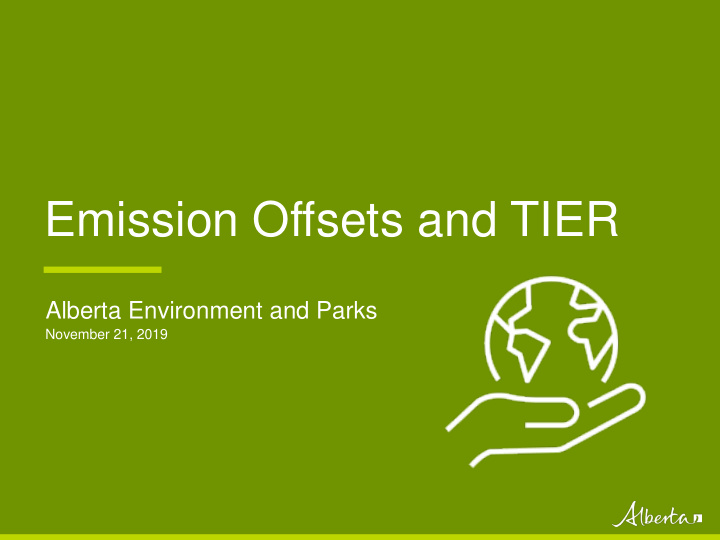



Emission Offsets and TIER Alberta Environment and Parks November 21, 2019
Topics • Regulatory Updates • Federal Fuel Charge • Conventional Oil and Gas • Industrial Heat • Grid Displacement Factor • Verifier Accreditation • Protocol Status
The Act and Regulation • Emissions Management and Climate Resilience Act (EMCRA) will replace the Climate Change and Emissions Management Act (CCEMA) on December 31, 2019. – Name of fund changed to Technology Innovation and Emissions Reduction Fund. • The Technology, Innovation and Emissions Reduction (TIER) regulation replaces the Carbon Competitiveness Incentive Regulation (CCIR). – Effective January 1, 2020. – Some clauses are effective Nov. 1, 2020 to enable opt-in. – No changes to expiry or credit limit for EPCs and offsets. – EPCs and offsets are still compliance mechanisms. – The regulation in effect at the time of serialization is the applicable regulation (not the vintage).
Deadlines • Last CCIR compliance deadline will be March 31, 2020; first TIER compliance deadline will be June 30, 2021 with no quarterly reporting. • Projects that expired between December 31, 2018 and January 1, 2020 may apply for an extension or additional extension before March 31, 2020. • Registry processing for registration submissions are one month prior to compliance deadline. • General registry processing up to 10 business days.
Aggregate Facilities • Opportunity for conventional oil and gas to be designated as an aggregate facility under TIER. – Stationary fuel combustion emissions subject to reduction target. • Benefits: facilities can apply for an exemption from federal fuel charge. – Continue to generate methane offsets. • Impacts: affects eligibility of engine fuel management offset projects. • Visit the TIER: Conventional Oil and Gas webpage at https://www.alberta.ca/conventional-oil-and-gas.aspx
Engine Fuel Pneumatics/Vent Management Gas Capture • Stationary fuel • Venting is not included in a facility’s total combustion is included in a facility’s total regulated emissions. regulated emissions. • Opportunity for offsets • No longer eligible for continues if designated offsets if opted in. as an aggregate.
Industrial Heat Regulated Facility Industrial Carbon Heat Regulated Facility Capture exported at benchmark Enhanced Oil Recovery
Industrial Heat • Industrial heat exported to another regulated facility, a carbon capture offset project and/or an enhanced oil recovery offset project is accounted for at the benchmark rate (0.06299 t/GJ). • Heat exported to an emission offset project other than a carbon capture or enhanced oil recovery project is not considered industrial heat. – This means that offset projects do not have to claim emissions associated with heat received from a regulated facility.
Verification • Verifiers must be accredited by June 30, 2023. • Accredited verifiers accepted beginning Jan.1, 2020 (ANSI, SCC, IAF). • If you are not an accredited verifier you can conduct verifications until June 30, 2023 as long as you are a registered professional engineer or accountant and meet experience requirements.
Alignment with Carbon Tax Jan-May 29, 2019 May 30 -Dec 31 2019 Jan. 1, 2020+ • Carbon levy in effect • No carbon levy or • Federal fuel charge federal fuel charge in effect • Offset Projects must: • Offset Projects may: • Offset projects must: • Report on levied • Include previously emissions levied emissions in • Report on offset emissions with • Exclude levied quantification fuel charge emissions from offset • Exclude emissions quantification with fuel charge from offset • Update project quantification plan by Jan. 1, 2019
Electricity Grid Displacement Factor Factor tCO2e/MWh Description Renewable electricity 0.53 Project displacing grid electricity with generation renewable generation Increased use of grid 0.57 For projects that increase use of electricity on-site electricity in project condition (includes line loss) Reduction in grid 0.57 For energy efficiency projects that electricity decrease electricity usage in the (includes line loss) project condition Distributed renewable 0.57 For projects displacing grid electricity displacement at point of with distributed renewable electricity use generation at point of use (includes line loss) • Grid Displacement Factor effective January 1, 2020 for new projects
Forest Carbon Forest Carbon Technical Experts Working Group developed a policy framework document and reported to government Government is working on finalizing a policy framework to support future protocol development Decision making process is underway to address recommendations from the working group
Ongoing Protocol Work Enhanced Oil Recovery Biogas Agricultural Nitrous Oxide Emissions Reduction Landfill Biocover Super-Utilization Conservation Cropping • Additionality analysis complete, seeking feedback on supplemental barriers
Flagged Protocols Solution Gas • Flagged because of Directive 084 and Conservation other known issues • Flagged because of overlap with federal fuel charge and aggregate/opt-in • Evaluating whether to withdraw or Engine Fuel revise Management • impact to crediting periods and and Vent Gas extensions depends on whether protocol Capture is withdrawn or revised • New projects or subprojects need director approval
Recommend
More recommend